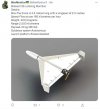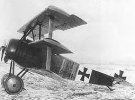Antares
Respected Leader
Shahed 136 dronen numeroita (jostain syystä poisti twiitin mutta otin siitä kuvan koska samoja numeroita näkee usein):

Minä kyllä epäilen suuresti tuota 2 500 km kantomatkaa. Lentonopeudella 185 km/h se tarkoittaisi 13,5 tunnin lentoaikaa. Polttoaineenkulutus ja kuinka suuri pa-tankki tarvitaan? Yleensä lentokoneissa suuri määrä polttoainetta varastoidaan siivissä, sama juttu tämän kanssa?
Jos kantomatka olisi todellakin tuo 2 500 km, miksi Venäjä on kuljettanut näitä Valko-Venäjälle? Miksei ammu omalta maalta ja lennä vain Valko-Venäjän ilmatilan läpi? Miksi tuoda nämä lähelle Ukrainan rajaa ja (ainakin teoriassa) altistaa ne vaaralle jos ei ole pakko?
Voin uskoa tuon 2 500 km mutta ainoastaan jos kyse on erikoisvarustellusta dronesta esim. drop tank tyylisillä lisätankeilla. Pidän paljon uskottavampana väitettä että kantomatka olisi 500 km kokoluokkaa, olisi silti pitkähkö jos vertaa erilaisiin ballistisiin ohjuksiin.
Wikipediasta löytyy yksi arvio hinnasta: $20,000 LÄHDE
CRISTIAN SEGURA, SPECIAL CORRESPONDENT
Kyiv - 12 OCT 2022 - 11:10 UTC
Dozens of so-called Iranian suicide drones have been flying over Ukrainian territory since August. These weapons are known as Shahed – a word that in the Islamic world can be translated as “witness of faith,” but also has connotations to the act of becoming a martyr – and they are theKremlin’s new favorite weapon in its invasion of Ukraine. The reduction of Russia cruise missile arsenal and a lack of technology have forced Moscow into the mass deployment of the devices manufactured in Iran, one of the few allies remaining to Russian President Vladimir Putin.
Ukrainian diplomatic sources in Washington told the press last week that on average, Kyiv’s air defense systems intercept six of these drones per day. The current model in use is the Shahed 136, renamed in Russia as the Geran-2, the most up-to-date version of suicide drone that has been in service since 2021. The Ukrainian General Staff says that its forces down 60% of the drones that reach Ukrainian airspace. But the number that Moscow is deploying is steadily increasing. On October 11 alone, 10 Shahed 136 drones were shot down. Two managed to get through and hit their target, a thermal power plant in Vinnytsia in central Ukraine. A day earlier, Russian forces deployed 13 of these from the Black Sea and Belarus. On October 4, 12 were sent into the Kyiv region, six of which hit infrastructure targets, according to the governor of the region, Oleksiy Kuleba. Russian Defense Minister Sergei Shoigu confirmed that over the last few days, 40 Geran-2 drones had been sent to positions in Belarus, from where they will strike at the Ukrainian capital.
Large-scale production of the Shahed 136 coincided with Russia’s invasion of Ukraine. Its primary adversary in the skies over Ukraine is the Turkish Bayraktar, one of the Ukrainian military’s most important weapons in the aerial war. The main advantage of the Shahed 136 is its combat range of over 2,000 kilometers, according to Ukrainian strategists. But unlike the Bayraktar, the Iranian models are single-use only and technologically inferior to the Turkish drones. Video footage of Shahed drones flying over Ukrainian territory confirms that they are easy to detect due to the amount of noise they make, which is similar to a moped, and because they generally do not exceed 180 kmph (111 mph).
Combat drones are one of the Russian military’s least advanced areas of warfare, compared to other major powers, according to Anton Mardasov, a military expert on the Syrian war at the Washington-based Middle East Institute think-tank. “The original plan in Ukraine failed in the first weeks of the invasion. Russia did not initially prepare for a traditional war of positioning; they focused instead on asymmetric warfare methods. They did not consider the use of drones as reusable strike weapons,” Mardasov says.
The Russian military deploys drones for reconnaissance purposes and redirecting artillery, but Moscow has a significant lack of attack drones, as Igor Ischuk, an advisor at the Russian Defense Ministry, admitted in an interview with the TASS news agency in September. “Russia does not produce drones that meet technical and tactical requirements,” Ischuk said. Moscow has a plentiful supply of Chinese drones for civilian and reconnaissance use, and these can be adapted for the front lines, but the Asian giant is not supplying Russia with significant quantities of combat drones. “What China will not do is let its friendship with Russia get in the way of its strategic objectives with Europe,” said Samuel Cranny-Evans, a research fellow at the Royal United Services Institute, the UK’s leading defense and security think-tank. Cranny-Evans emphasizes that Russia is lagging behind, especially in terms of unmanned vehicles capable of bombing missions: “They were using Orions at the beginning of the war, but [Ukraine] seems to have shot them down.”
The option of turning to Iran was an obvious one for the Kremlin, says Mardasov, because technological cooperation between the two countries has been on the rise since the beginning of the Syrian Civil War in 2011, where Russian troops fought for the dictator Bashar al-Assad alongside forces provided by Tehran. Russian troops used drones in Syria and their pilots were trained in Iran.
NATO’s intelligence services have been speculating over the past few weeks as to how much is left in Moscow’s cruise missile arsenal: the intensity of the Russian bombardment has few precedents in contemporary conflicts. The Economist stated in June, citing US military analysts, that in two weeks alone Russia had fired an amount of artillery equivalent to the total annual production of the United States military.
The UK Ministry of Defense stated in an October 1 report that Russian forces were deploying missiles from air defense systems to attack targets on the ground. In the September 30 bombardment in Zaporizhzhia that left 30 civilians dead, Russia fired S-300 surface-to-air missiles, originally designed by the Soviet Union as a defense system against cruise missile attacks and conventional air raids. When redeployed from use in the air to ground use, these weapons lose their accuracy. “Their use in ground attacks is most likely due to a lack of available ammunition, especially in terms of precision and long-range missiles. The fact that Russia is using the Shahed 136 and 129, and the Mohajer-6, clearly indicates that they are suffering from a shortage of KH-101, Kalibr and KH-55 [long-range] missiles,” Ukrainian Air Force spokesman Yurii Ihnat said on October 5.
Cranny-Evans believes that the massive influx of Iranian drones will continue, at least as long as Russia is experiencing delays in missile production. The analyst says he could not quantify how international sanctions on Russia were affecting Moscow’s military industry because it could be using old parts to plug the gap. However, Cranny-Evans notes that Kalibr missiles particularly “rely heavily” on foreign-made components.
Another reason Moscow is favoring the use of Iranian drones is because they are considerably cheaper than cruise missiles: these figures are kept classified, but Cranny-Evans estimates that a single Shahed 136 costs in the region of $20,000 to construct. A Russian cruise missile can cost anywhere between $4 million and $14 million. “It is clear that it is much cheaper to use Iranian drones, produced with Iranian components, and with an engine that looks like one from a lawnmower,” said Mardasov. The disadvantage of these weapons, the Russian expert says, is that they do not meet one key requirement: effectiveness against artillery positions. Their main advantage is that they have proven to be effective and quite accurate against fixed targets.
Jos hinta pitäisi edes karkeasti paikkansa niin en ihmettelisi vaikka näitä köyhän miehen risteilyohjuksia alkaisi näkymään entistä tiuhempaan. Samaa on toki ennustettu yleisesti erilaisten UAV-laitteiden osalta jo Irakin sodan vuosilta, tosin tuorein suurempi kohina seurasi Armenian ja Azerbaijanin lyhyttä sotaa vuodelta 2020.
Varsinkin lännessä on panostettu suurella rahalla ilmavoimiin ja usein perinteinen lyhyen tai keskipitkän kantomatkan ilmatorjunta on sivuutettu miltei kokonaan. Teoriassa tietysti pitää paikkansa että jos on täydellinen ilmaherruus niin vihollinen ei pääse operoimaan ja silloin erilaiset maavoimia tukevat ilmatorjunta-aseet ovat hyödyttömiä (paitsi jos niitä voi käyttää maamaaleja vastaan). Sanoisin että tuo teoria vesittyy ainakin osittain, jos vihollisella on suuria määriä halvahkoja lentäviä pommeja. Silloin niiden torjuntaa pitää myös olla massamaisesti ja sen pitää kyetä reagoimaan nopeasti (hävittäjiä ei kannata tuhlata 24/7 päivystyslentoihin siltä varalta jos näitä sattuisi ilmaantumaan) eikä keinovalikoima voi olla kalliimpi kuin kyseinen torjuttava lentävä pommi.
Toisaalta en pitäisi pahana vaikka Suomella olisi käytössä vastaavanlaisia virityksiä. Ryssäläisen kyky torjua näitä on koeponnistamatta ja vaikka heillä on suurta mainetta nauttiva tutka- ja ilmatorjuntajärjestelmä (moniportainen, monta eri järjestelmää yhdessä) niin uskon että sekin olisi helisemässä jos isketään suurella määrällä yhtä aikaa monesta eri suunnasta (swarm hyökkäykseksi jotkut tuota sanovat).

Minä kyllä epäilen suuresti tuota 2 500 km kantomatkaa. Lentonopeudella 185 km/h se tarkoittaisi 13,5 tunnin lentoaikaa. Polttoaineenkulutus ja kuinka suuri pa-tankki tarvitaan? Yleensä lentokoneissa suuri määrä polttoainetta varastoidaan siivissä, sama juttu tämän kanssa?
Jos kantomatka olisi todellakin tuo 2 500 km, miksi Venäjä on kuljettanut näitä Valko-Venäjälle? Miksei ammu omalta maalta ja lennä vain Valko-Venäjän ilmatilan läpi? Miksi tuoda nämä lähelle Ukrainan rajaa ja (ainakin teoriassa) altistaa ne vaaralle jos ei ole pakko?
Voin uskoa tuon 2 500 km mutta ainoastaan jos kyse on erikoisvarustellusta dronesta esim. drop tank tyylisillä lisätankeilla. Pidän paljon uskottavampana väitettä että kantomatka olisi 500 km kokoluokkaa, olisi silti pitkähkö jos vertaa erilaisiin ballistisiin ohjuksiin.
Wikipediasta löytyy yksi arvio hinnasta: $20,000 LÄHDE
Iranian ‘suicide’ drones: Russia’s new favorite weapon in Ukraine war
Iran is supplying hundreds of unmanned combat vehicles to Moscow, which lacks such technology and has severely depleted its cruise missile arsenal
CRISTIAN SEGURA, SPECIAL CORRESPONDENT
Kyiv - 12 OCT 2022 - 11:10 UTC
Dozens of so-called Iranian suicide drones have been flying over Ukrainian territory since August. These weapons are known as Shahed – a word that in the Islamic world can be translated as “witness of faith,” but also has connotations to the act of becoming a martyr – and they are theKremlin’s new favorite weapon in its invasion of Ukraine. The reduction of Russia cruise missile arsenal and a lack of technology have forced Moscow into the mass deployment of the devices manufactured in Iran, one of the few allies remaining to Russian President Vladimir Putin.
Ukrainian diplomatic sources in Washington told the press last week that on average, Kyiv’s air defense systems intercept six of these drones per day. The current model in use is the Shahed 136, renamed in Russia as the Geran-2, the most up-to-date version of suicide drone that has been in service since 2021. The Ukrainian General Staff says that its forces down 60% of the drones that reach Ukrainian airspace. But the number that Moscow is deploying is steadily increasing. On October 11 alone, 10 Shahed 136 drones were shot down. Two managed to get through and hit their target, a thermal power plant in Vinnytsia in central Ukraine. A day earlier, Russian forces deployed 13 of these from the Black Sea and Belarus. On October 4, 12 were sent into the Kyiv region, six of which hit infrastructure targets, according to the governor of the region, Oleksiy Kuleba. Russian Defense Minister Sergei Shoigu confirmed that over the last few days, 40 Geran-2 drones had been sent to positions in Belarus, from where they will strike at the Ukrainian capital.
Large-scale production of the Shahed 136 coincided with Russia’s invasion of Ukraine. Its primary adversary in the skies over Ukraine is the Turkish Bayraktar, one of the Ukrainian military’s most important weapons in the aerial war. The main advantage of the Shahed 136 is its combat range of over 2,000 kilometers, according to Ukrainian strategists. But unlike the Bayraktar, the Iranian models are single-use only and technologically inferior to the Turkish drones. Video footage of Shahed drones flying over Ukrainian territory confirms that they are easy to detect due to the amount of noise they make, which is similar to a moped, and because they generally do not exceed 180 kmph (111 mph).
Moscow orders 2,400 Iranian drones
Pentagon sources told The Washington Post last week that Tehran has supplied Russia with “hundreds of different types of drones,” not only various Shahed models but also Mohajer-6 reconnaissance and attack drones. The Ukrainian intelligence services place the total number of unmanned vehicles that Moscow has ordered from Iran at 2,400.Combat drones are one of the Russian military’s least advanced areas of warfare, compared to other major powers, according to Anton Mardasov, a military expert on the Syrian war at the Washington-based Middle East Institute think-tank. “The original plan in Ukraine failed in the first weeks of the invasion. Russia did not initially prepare for a traditional war of positioning; they focused instead on asymmetric warfare methods. They did not consider the use of drones as reusable strike weapons,” Mardasov says.
The Russian military deploys drones for reconnaissance purposes and redirecting artillery, but Moscow has a significant lack of attack drones, as Igor Ischuk, an advisor at the Russian Defense Ministry, admitted in an interview with the TASS news agency in September. “Russia does not produce drones that meet technical and tactical requirements,” Ischuk said. Moscow has a plentiful supply of Chinese drones for civilian and reconnaissance use, and these can be adapted for the front lines, but the Asian giant is not supplying Russia with significant quantities of combat drones. “What China will not do is let its friendship with Russia get in the way of its strategic objectives with Europe,” said Samuel Cranny-Evans, a research fellow at the Royal United Services Institute, the UK’s leading defense and security think-tank. Cranny-Evans emphasizes that Russia is lagging behind, especially in terms of unmanned vehicles capable of bombing missions: “They were using Orions at the beginning of the war, but [Ukraine] seems to have shot them down.”
The option of turning to Iran was an obvious one for the Kremlin, says Mardasov, because technological cooperation between the two countries has been on the rise since the beginning of the Syrian Civil War in 2011, where Russian troops fought for the dictator Bashar al-Assad alongside forces provided by Tehran. Russian troops used drones in Syria and their pilots were trained in Iran.
NATO’s intelligence services have been speculating over the past few weeks as to how much is left in Moscow’s cruise missile arsenal: the intensity of the Russian bombardment has few precedents in contemporary conflicts. The Economist stated in June, citing US military analysts, that in two weeks alone Russia had fired an amount of artillery equivalent to the total annual production of the United States military.
The UK Ministry of Defense stated in an October 1 report that Russian forces were deploying missiles from air defense systems to attack targets on the ground. In the September 30 bombardment in Zaporizhzhia that left 30 civilians dead, Russia fired S-300 surface-to-air missiles, originally designed by the Soviet Union as a defense system against cruise missile attacks and conventional air raids. When redeployed from use in the air to ground use, these weapons lose their accuracy. “Their use in ground attacks is most likely due to a lack of available ammunition, especially in terms of precision and long-range missiles. The fact that Russia is using the Shahed 136 and 129, and the Mohajer-6, clearly indicates that they are suffering from a shortage of KH-101, Kalibr and KH-55 [long-range] missiles,” Ukrainian Air Force spokesman Yurii Ihnat said on October 5.
Cranny-Evans believes that the massive influx of Iranian drones will continue, at least as long as Russia is experiencing delays in missile production. The analyst says he could not quantify how international sanctions on Russia were affecting Moscow’s military industry because it could be using old parts to plug the gap. However, Cranny-Evans notes that Kalibr missiles particularly “rely heavily” on foreign-made components.
Another reason Moscow is favoring the use of Iranian drones is because they are considerably cheaper than cruise missiles: these figures are kept classified, but Cranny-Evans estimates that a single Shahed 136 costs in the region of $20,000 to construct. A Russian cruise missile can cost anywhere between $4 million and $14 million. “It is clear that it is much cheaper to use Iranian drones, produced with Iranian components, and with an engine that looks like one from a lawnmower,” said Mardasov. The disadvantage of these weapons, the Russian expert says, is that they do not meet one key requirement: effectiveness against artillery positions. Their main advantage is that they have proven to be effective and quite accurate against fixed targets.
Jos hinta pitäisi edes karkeasti paikkansa niin en ihmettelisi vaikka näitä köyhän miehen risteilyohjuksia alkaisi näkymään entistä tiuhempaan. Samaa on toki ennustettu yleisesti erilaisten UAV-laitteiden osalta jo Irakin sodan vuosilta, tosin tuorein suurempi kohina seurasi Armenian ja Azerbaijanin lyhyttä sotaa vuodelta 2020.
Varsinkin lännessä on panostettu suurella rahalla ilmavoimiin ja usein perinteinen lyhyen tai keskipitkän kantomatkan ilmatorjunta on sivuutettu miltei kokonaan. Teoriassa tietysti pitää paikkansa että jos on täydellinen ilmaherruus niin vihollinen ei pääse operoimaan ja silloin erilaiset maavoimia tukevat ilmatorjunta-aseet ovat hyödyttömiä (paitsi jos niitä voi käyttää maamaaleja vastaan). Sanoisin että tuo teoria vesittyy ainakin osittain, jos vihollisella on suuria määriä halvahkoja lentäviä pommeja. Silloin niiden torjuntaa pitää myös olla massamaisesti ja sen pitää kyetä reagoimaan nopeasti (hävittäjiä ei kannata tuhlata 24/7 päivystyslentoihin siltä varalta jos näitä sattuisi ilmaantumaan) eikä keinovalikoima voi olla kalliimpi kuin kyseinen torjuttava lentävä pommi.
Toisaalta en pitäisi pahana vaikka Suomella olisi käytössä vastaavanlaisia virityksiä. Ryssäläisen kyky torjua näitä on koeponnistamatta ja vaikka heillä on suurta mainetta nauttiva tutka- ja ilmatorjuntajärjestelmä (moniportainen, monta eri järjestelmää yhdessä) niin uskon että sekin olisi helisemässä jos isketään suurella määrällä yhtä aikaa monesta eri suunnasta (swarm hyökkäykseksi jotkut tuota sanovat).
Viimeksi muokattu:





